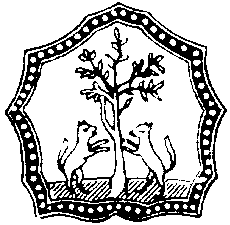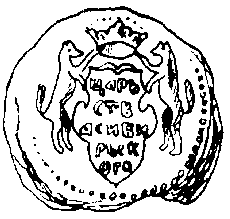Beginning of the part
The second of the XVIIth century
The first half of the XVIIIth century
The second half of the XVIIIth century
The first half of the XIXth century
The second half of the XIXth century
Beginning of the XXth century

Emblem of the Siberian Empire,
drawn on the throne of the Russian Tsar Michael Fedorovich Romanov (the second quarter of the XVIIth century)

Seal of the Siberian Empire
(XVII ΧΕΛ)
|
After the doom of the Siberian Empire various tribes and people became members of
Russian Federation. At the end of the XVIth century the fortress and town Tjumen
(1586), Tobolsk (1587), Tara (1594) and others, which assigned the part of
West Siberia to Russian Federation, were built in Transural.
The penetration of the russian troops to the southern part of West Siberia is
connected with the forward movement to the East. In 1604 on the Tom, the right tributary of the Ob,
on the teritory of Tomsk Tatars the wooden fortress Tomsk was built. In 1618 the Tomsk
service men, collecting the tribute from the inhabitans, founded a new fortification
in the Upper Tom - Kuznetsk. But here the forward movement to the south stopped.
In the middle of the XVIIth century Cossak troops reached the Pacific Ocean, but
not the mouth of the Katun and the Bija.
In the first half of the XVIIth century the tribes of the Mongolian-speaking
Oirats and Turcik-speaking Teleuts (forefathers of the present-day southern Altai
people) lived there. Russians believed theu both to be Kalmicks, but they call
Mongolian "black" and Teleuts "white Kalmicks". Teleuts conceded conciderably in
force to the Oirat union. The troop of the Teleut prince Abak consisted of about
one thousand men, while the Mongolian leaders had from 5 to 10 thousand men.
In the 1620-s Hara-Hoola - one of the most influential Oirat leaders - lived in the
mouth of the Chumish, the right tributery of the Ob, who after the doom of East-Mongolian
Khans wandered to the North, to the Upper Ob-side. In the mouth of the Chumish
the fortress was built by Mongolians in account of the possible attack.
In 1635 after the death of Hara-Hoola the Oirat unionwas headed by his son Bator,
who became "hontaidgi", that means "governor". They say, that event signified the foundation
of the West-Mongolian State - Dgungaria. At that time in summer on the edict of Bator-
hontaidgi alman-collectors ("alman" - tribute, tax) were sent to Teleut prince Abak.
In autumn 1635 Abak died, his elder son Koka became the prince. To the middle
of the XVIIth century, as Dgungaria in tensified its influence, the tribute dependence
of Teleuts on "black Kalmicks" increased little by little. It's known that in 1647
Prince Koka gave horses to the Mongolian governor as a tribute.
The relations of Teleuts with the Russian State were a little bit different.
Teleuts stayed one of few Turcik-speaking people of West Siberia, which didn't pay
"jassak" (=tribute) to the Russian Tsar.
The interrelations between Teleuts and the Siberian goverment were not one-sided:
sometimes there was peace between them, sometimes they fought. One of the causes
|